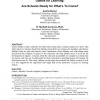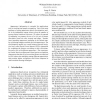194 search results - page 4 / 39 » Learning whom to trust: using graphical models for learning ... |
IWCM
2004
Springer
13 years 10 months ago
2004
Springer
We present a probabilistic framework for component-based automatic detection and tracking of objects in video. We represent objects as spatio-temporal two-layer graphical models, w...
CHI
2007
ACM
13 years 9 months ago
2007
ACM
Software developers must modify their programs to keep up with changing requirements and designs. Often, a conceptually simple change can require numerous edits that are similar b...
DIGRA
2005
Springer
13 years 10 months ago
2005
Springer
Games Studies is still a relatively new field where much basic research remains to be done. This study asks K-12 teachers about their attitudes towards the use of games for teachi...
CSCW
2006
ACM
13 years 11 months ago
2006
ACM
This paper presents a grounded theory of information sharing behavior of the users of a personal learning space. A personal learning space is an environment consisted of weblog, e...
SIBGRAPI
2009
IEEE
13 years 11 months ago
2009
IEEE
Appearance information is essential for applications such as tracking and people recognition. One of the main problems of using appearance-based discriminative models is the ambig...


